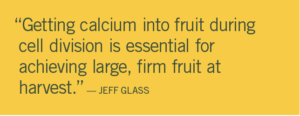Calcium Crucial For Citrus Fruit Development
The four to eight weeks after petal fall is the most crucial time developing fruit needs calcium. Missing this window will have a negative impact on yield.
 The first stage of citrus fruit development is extremely important when it comes to citrus calcium demands. This fruit cell division period usually lasts anywhere from four-to-eight-weeks after bloom. During this last window, the foundation of the fruit is being determined. Calcium is the key element in this equation because it plays a vital role in cell division and cell wall integrity. Without enough calcium in the fruit at this time, fewer cells will form.
The first stage of citrus fruit development is extremely important when it comes to citrus calcium demands. This fruit cell division period usually lasts anywhere from four-to-eight-weeks after bloom. During this last window, the foundation of the fruit is being determined. Calcium is the key element in this equation because it plays a vital role in cell division and cell wall integrity. Without enough calcium in the fruit at this time, fewer cells will form.
Even though later in the season cells expand, the fact that there are fewer cells means the fruit will be smaller. The more cells there are to expand, the larger the ultimate fruit size. Once cell division stops and expansion begins, calcium cannot help create more cells. No amount of optimum nutrition or environmental conditions will make up for a lack of calcium during this crucial time.
Calcium is one of the most immobile nutrients found in plant tissue and getting it into citrus trees via roots stressed by HLB (Huanglongbing, or citrus greening) can be difficult. Just because a nutrient is in the soil in adequate levels, it doesn’t mean it gets into the tree, and just because it’s in the tree, doesn’t guarantee that it gets in the fruit. Foliar calcium fertilizers are available, but the formulation is important. By attaching a calcium cation to a phosphite molecule, Agro-K provides a product that increases the possibility of calcium reaching inside the citrus fruit when needed the most.
Agro-K’s Sysstem®-CAL is in true phosphite form, which means it is a calcium and acid reacted product. This product does not contain any potassium, so it is not a potassium phosphite with finely ground calcium added to the jug. Phosphites are easily absorbed by the leaves as well as newly forming fruit. Sysstem- CAL is the best calcium source for penetration of fruit during stage one, the fruit cell division period. It helps address the fact that calcium is so immobile. A foliar application of Sysstem-CAL gets calcium into the developing fruit quickly and efficiently.
“Sysstem-CAL contains calcium in solution, not suspension, which is a significant difference, says Jeff Glass, Southern Business Development Manager at Agro-K. If you look at a glass of Sysstem-CAL, it has a colored tint to it and is transparent. Other calcium products are a milky white or grey color that lacks transparency. This is due to the calcium being finely ground and in suspension. Calcium in suspension does not readily enter the plant. Phosphites are the most foliar-friendly products on the market today with rapid uptake and movement within the xylem and phloem.”
Phosphites move into the plant very easily, so uptake of the attached nutrients into the leaf and fruit happens quickly, Glass explains. This is a significant advantage of nutrients in phosphite form because they can move within the plant easily, as well, including to roots, shoots, and leaf tips.
“In addition to aiding in fruit cell division, calcium strengthens cell walls, enhances firmness, and improves overall fruit quality.”
Sysstem-CAL is tank-mix compatible with most insecticides, fungicides, and plant growth regulators.
To find out more about how Sysstem-CAL can help increase your yield, contact your Nutrien or Triangle representative. Call or email Jeff Glass at (850) 545-9004 | glass@agro-k.com.



